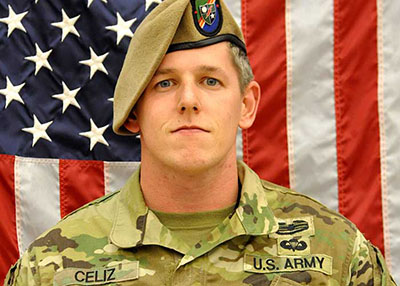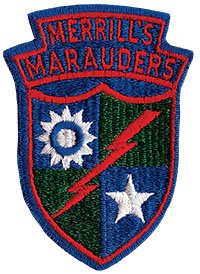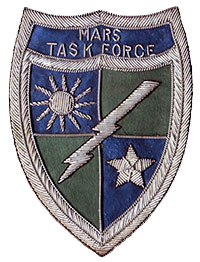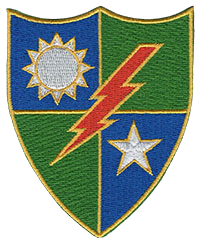DOWNLOAD
Military insignia serve as both unit identifiers and sources of inspiration. Their symbolism connects present-day units to their historical predecessors. While insignia may be instantly recognizable, the symbols they contain often require explanation. The description that follows provides historical context for the current U.S. Army 75th Ranger Regiment Distinctive Unit Insignia (DUI). The Ranger regiment has roots to multiple World War II units, but the story of the DUI itself starts in the Burma campaign.

Sergeant First Class Christopher A. Celiz was posthumously awarded the Medal of Honor for actions while serving with 1st Battalion, 75th Ranger Regiment in Afghanistan. He wears the 75th Ranger Regiment DUI on his beret.
A British colony, Burma was invaded by the Japanese in early 1942. In order to take back its former territory and to secure India from threat of invasion, the British attempted a number of military operations. Although costly, the most daring of these was infiltrating a long-range penetration group, known as the Chindits, into Japanese-controlled Burma. Led by Brigadier General Orde Wingate, in February 1943, 3,000 Chindits entered north Burma and succeeded in causing limited damage to the Japanese, but at great cost in personnel.1 The Chindits, however, secured a propaganda victory by showing that allied units could operate successfully behind enemy lines. This led the US. Army to create its own long range penetration group, the 5307th Composite Unit (Provisional), otherwise known as Merrill’s Marauders.
In February 1944, the Marauders began their own campaign in Burma. They were pivotal in seizing the airfield at Myitkyina, in north Burma, and after three months of siege, the city itself. However, that campaign rendered the unit combat ineffective. Because the 5307th was no longer capable of operations, on 10 August 1944, remaining Marauders—along with their unit lineage—were consolidated into the 475th Infantry Regiment (Long Range Penetration, Special), part of the 5332nd Brigade (Provisional), better known as the MARS Task Force. The MARS Task Force was the second U.S. Army long range penetration unit formed for service in Burma in WWII. It was instrumental in seizing the remainder of the Burma Road from Japanese control, opening up a land route to China, and securing north Burma. The 475th, as well as the other component units in the MARS Task Force, were disbanded in China on 1 July 1945.2 For nearly a decade, the two U.S. Army long range penetration groups seemingly were just a memory.
That changed on 20 November 1954, with the activation of the 75th Infantry Regiment on Okinawa. The 75th Infantry Regiment in the mid-1950s was not considered a ‘Ranger’ unit and at the time had no formal ties to the six WWII Ranger Battalions. However, the 75th drew its lineage directly from Merrill’s Marauders and the 475th Infantry Regiment. This heritage was reflected on the 75th’s DUI, the description of which read:
“Blue is the color for Infantry. The two elephant tusks are used to represent Burma, and in forming and arch supporting the Indian Star allude to Burma being the eastern ‘Gateway to India.’ The red stripe leading through the gateway signifies the defense of India and central Burma, the areas in which the regiment was engaged. The two crossed kukris (Gurkha knives) barring the gateway are used to represent the regiment’s two battle honors for service during World War II, and also symbolized the nature of jungle combat. The tusks and kukris taken together simulate the letter ‘M’ and refer to ‘Merrill’s Marauders,’ its famed World War II designation.3
The 75th had only a short existence before being inactivated on 21 March 1956.4 The lineage to the Marauders and the 475th again went dormant.


On 1 January 1969, the 75th Infantry Regiment was reorganized to become the “parent organization” for all Department of the Army-authorized long range patrol units, under the Combat Arms Regimental System.5 The 75th retained its lineage to the Marauders and the 475th, but the unit was also granted an exception to policy that allowed it to adopt another DUI. For its DUI, the 75th chose to adapt the shoulder patch of the Marauders, which had also been worn by the 475th and the rest of the MARS Task Force. While never officially authorized, this patch was widely worn in Burma during WWII and symbolized those units. The DUI description reads:
“The colors blue, white, red and green represent four of the original six combat teams of the 5307th Composite Unit (Provisional), commonly referred to as Merrill's Marauders, which were identified by color. To avoid confusion, the other two colors, khaki and orange, were not represented in the design; however, khaki was represented by the color of the uniform worn by US forces in the China-Burma-India Theater during World War II. The unit's close cooperation with the Chinese forces in the China-Burma-India Theater is represented by the sun symbol from the Chinese flag. The white star represents the Star of Burma, the country in which the Marauders campaigned during World War II. The lightning bolt is symbolic of the strike characteristics of the Marauders' behind-the-line activities.6

On 3 February 1986, the 75th Infantry Regiment was redesignated as the 75th Ranger Regiment. The redesignation led to the Rangers, after a long struggle, claiming official lineage to the WWII Ranger Battalions, which had previously been assigned to U.S. Army Special Forces.7 The Rangers were later able to show this additional World War II heritage in the form of their Shoulder Sleeve Insignia (SSI), the adoption of which is another story. However, the 75th Ranger Regiment retained the same DUI that had been approved for wear on 18 March 1969, thereby honoring the contributions of the Marauders and the 475th Infantry to Ranger history and legacy.

